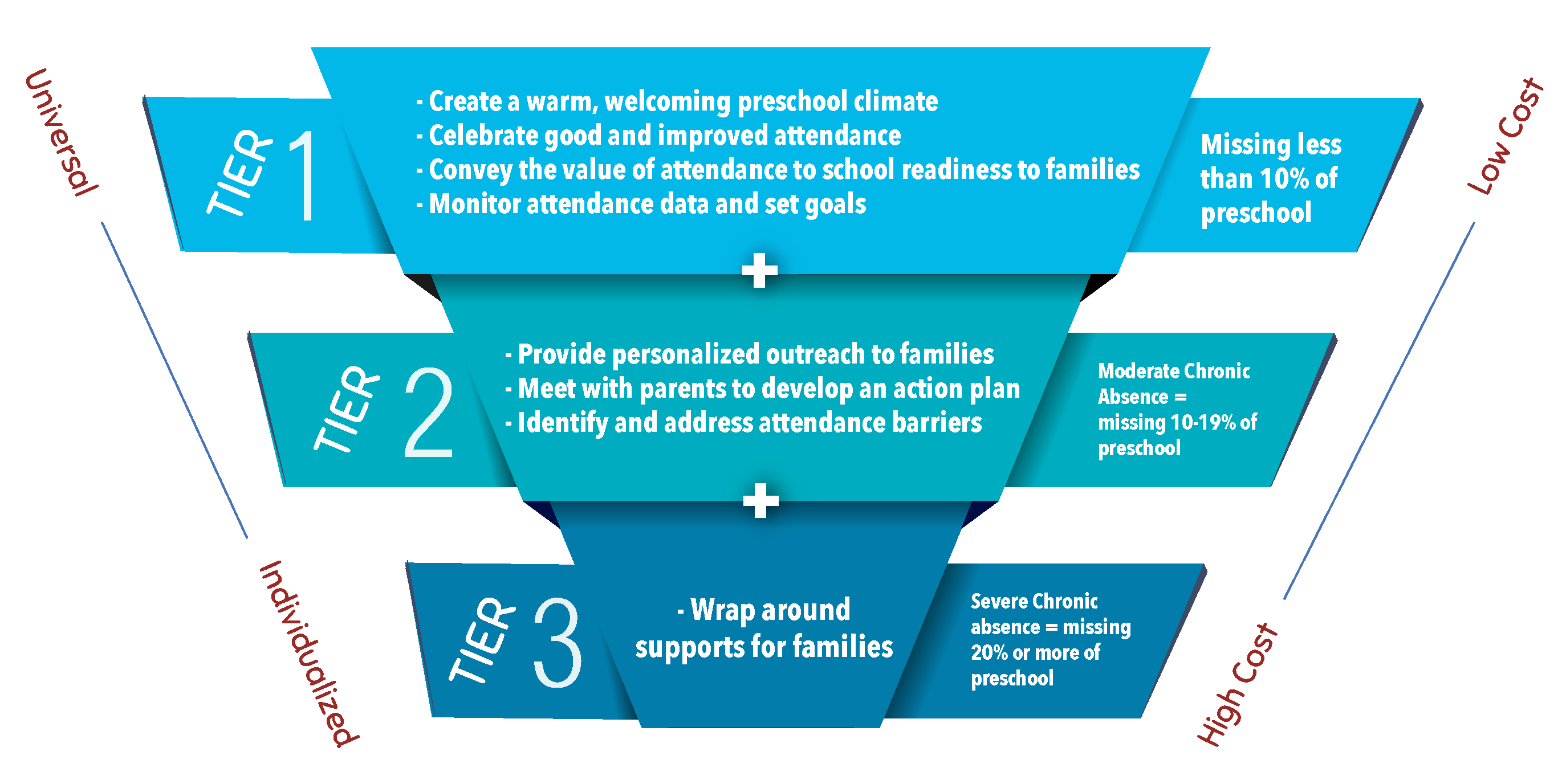Using Attendance Tiers and Data
Tiers of Data: Tiers of Action
While it is helpful to encourage families and children to track absences, early education programs and their staff can use the data they maintain on attendance to identify when students are starting to miss too much preschool so they can intervene as early as possible.
What works to secure and then regularly review data varies depending upon the program or center’s capacity to use data. Access to and policies on preschool attendance data vary widely. Below you can read about our free data tools available through Attendance Works as well as information about management systems which offer chronic absence reports.
Use attendance data to determine how many children you serve fall into each of the three tiers of intervention to understand what you need to put in place to support improved attendance.
Don’t forget to recognize achievement in all the tiers. Changing habits is hard work, for staff, for families and for children!

Tools for Gathering Data
Early education programs can use the data they maintain on attendance to identify when students are starting to miss too much preschool. Read on and learn how to gather the necessary data, how to use data and a summary of current attendance data policies.
Preschool Attendance Tracking Tool
Attendance Works created the Preschool Attendance Tracking Tool (PATT) to help programs produce chronic absence reports. Available for download at no cost, this Excel-based data tool creates charts that segregate data into three levels: less than 10 percent absence (strong attendance for preschool), 10-19.99 percent absence (moderate chronic absence) and 20 percent or more (severe chronic absence). These charts provide at-a-glance updates on attendance, so that preschool attendance leaders and teams quickly understand where their greatest attendance challenges lie.
The PATT is aligned with our attendance tracking tools for schools and districts to allow the transition of information from preschools into elementary schools. Click here to register for access to the Preschool Attendance Tracking Tool (PATT).
Building off the PATT example, three data management companies, COPA, ChildPlus and Promis/MyHeadStart.com now offer chronic absence reports nested within their data systems. We are happy to work with preschool and elementary data management systems to make chronic absence reports easily accessible at the preschool level.
For further information about how to use and interpret chronic absence data, please see this guidance.
Spreadsheet Collection
Preschools that don’t have a student information system and have a modest number of children enrolled can also use an Excel spreadsheet to track attendance and then calculate the percent of days missed. If needed, data can be collected by hand and then a staff person can enter it into the spreadsheet.
Collecting Data the Old-Fashioned Way
If your preschool doesn’t yet have electronic or spreadsheet attendance data capacity, consider this “old fashioned” option:
The process makes your attendance roster transparent to the children and to the adults who bring them and pick them up. You can also use this to reinforce your lessons on counting, sorting, and days and dates.
Using the Data
The most important thing about the data is not how you get it, but how you use it.
Segmenting the absence data into tiers allows you to see where your biggest challenges are and where the opportunities for recognition and celebration lie. Once you have a sense of the overall situation, you may want to analyze the information further to see if there are concentrations in certain classrooms, or in demographic groupings or neighborhood clusters that offer clues to problem solving.
Once the classroom rosters have stabilized, review the data at least once a month and compare months.
Early informed outreach and support can help resolve issues and reassure families that their child’s presence is valued. The habits and attitudes formed in preschool can set a long-term trajectory. Help make it a positive one that leads to success in elementary school and beyond!
Preschool is an ideal time to help children and families develop strong attendance habits.
Attendance Works urges preschool providers to monitor chronic absence in addition to average daily attendance and reach out to families when a child is missing 10 percent of days enrolled or just 2 days in a month.
The new Head Start Performance Standards include changes that mirror the definition and strategies of reducing chronic absence. The new requirements also reflect the growing awareness of the importance of establishing strong attendance habits from the outset of schooling.
In addition to the traditional 85 percent Average Daily Attendance reporting requirement, the Head Start Performance Standards require programs to:
The Every Student Succeeds Act (ESSA) requires schools, districts and states to track and monitor chronic absence in K-12 settings. The majority of states (36 plus the District of Columbia) have currently adopted a chronic absence metric as a component of school accountability in their state ESSA plans.
High levels of kindergarten chronic absence can be a sign that schools are not leveraging their investments in early education to prevent and address chronic absence among the youngest students. In states and districts which offer public preschool, preschool teachers typically take attendance every day and enter it into an electronic system. This creates a strong potential for tracking and addressing chronic absence in preschool.
Private programs have a range of policies and approaches for tracking absences. Most set their own policies and expectations for attendance. Some use computerized systems while others track with pencil and paper.